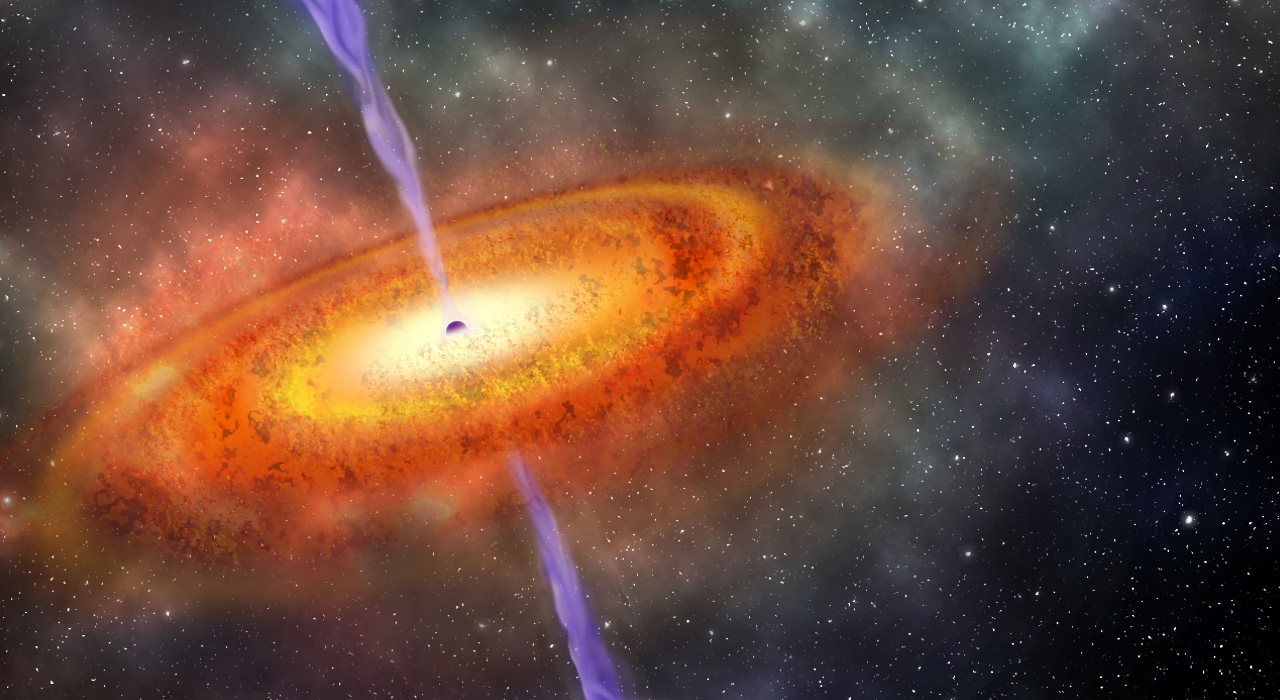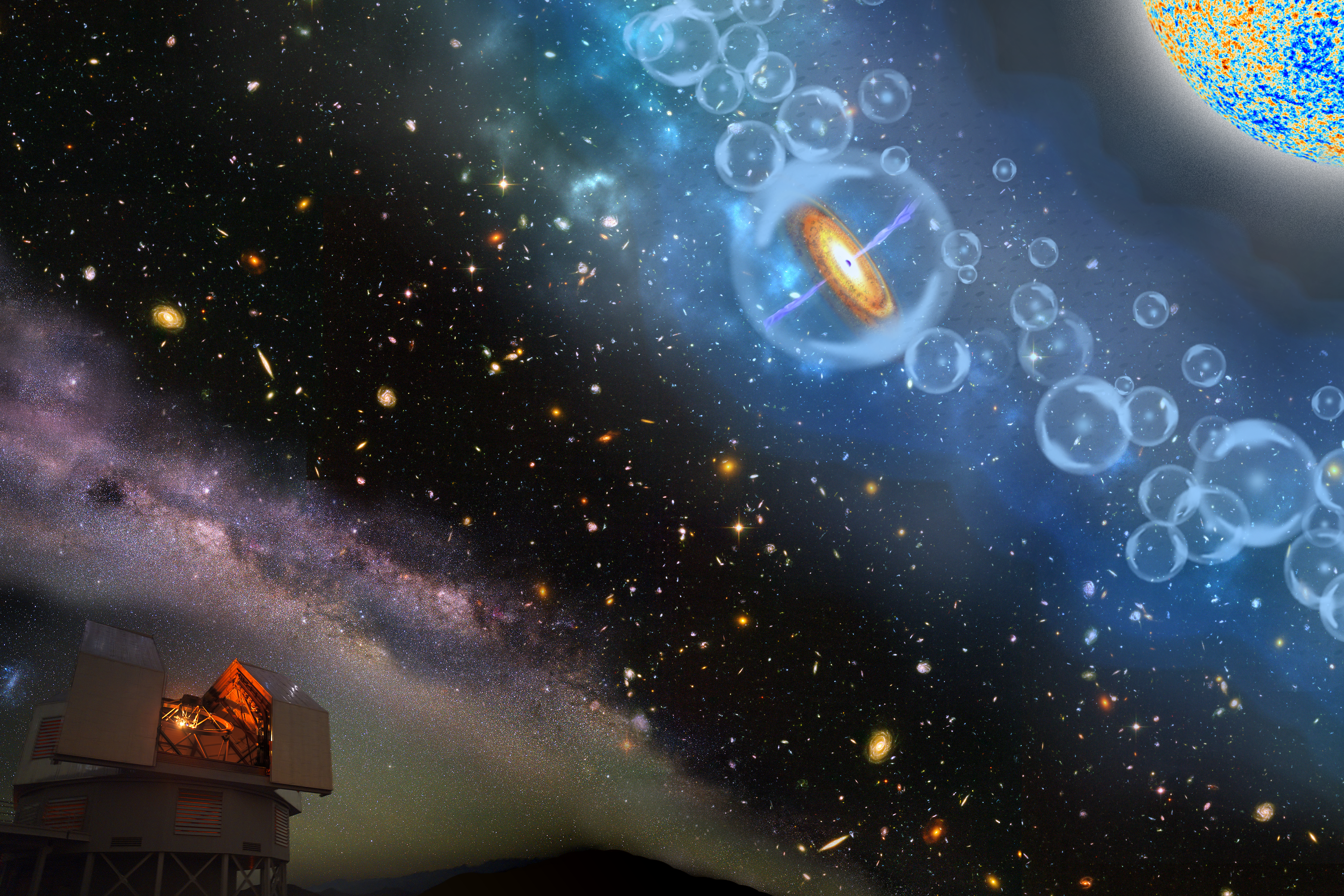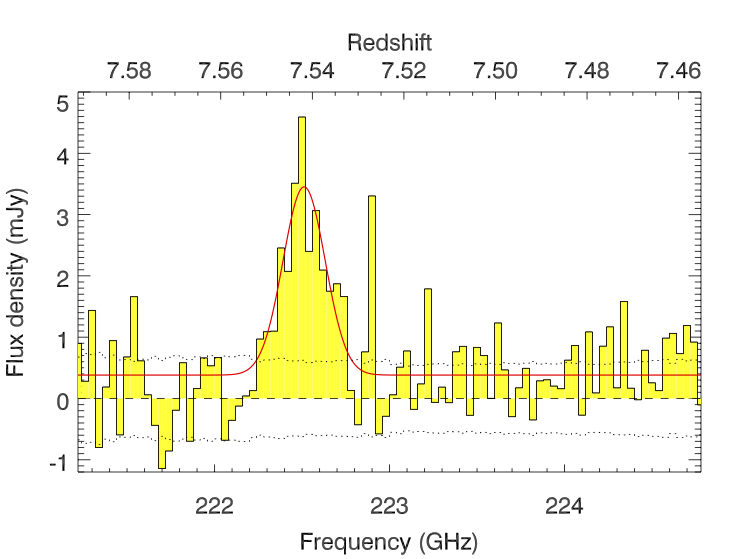News
The most distant black hole in the cosmos
 |
|
Artist's impression of a quasar: a supermassive black hole, surrounded by an accretion disk of material. Astronomers have found the most distant quasar yet known, and used it to obtain key information about the early universe. Credit: Carnegie Institution for Science |
An international team of astronomers has discovered the most distant black hole known: a so-called quasar whose light has taken 13 billion years to reach us. In consequence, the light shows this quasar as it was 13 billion years ago, a mere 690 million years after the Big Bang.
The discovery was part of a concerted, multi-year search for ever more distant quasars led by Fabian Walter and Bram Venemans of the Max Planck Institute for Astronomy. It was made by Eduardo Bañados, of the Carnegie Institution for Science, using the institution's 6.5 meter Magellan telescopes in Chile.
In an effort led by MPIA's Bram Venemans, the astronomers targeted the quasar with the millimeter interferometer NOEMA, operated by IRAM, in the French Alps and the VLA radio telescope array in Socorro, New Mexico. The first NOEMA observations, with 8 antennas observing in unison, were undertaken mere days after Bañados had first discovered the quasar, and they showed clear traces of the quasar's host galaxy. Using the spectral lines of ionized carbon, commonly designated [CII], and the dust continuum, this analysis showed that the newly discovered quasar was very special indeed. The [CII] line observation with NOEMA particularly allowed to determine with high precision the quasar redshift as z=7.54.
With those observations, the astronomers were able to identify and examine the quasar's host galaxy. Although the galaxy can be no more than 690 million years old, it has already formed an enormous amount of dust, and heavy chemical elements. This means it must already have formed a large amount of stars. Again, this is a challenge for models of galaxy evolution. Bram Venemans says: "Models of galaxy evolution will need to explain how a galaxy could form the stars needed to produce the observed amounts of dust and heavier chemical elements in such a comparatively short time."
Quasars are powered by supermassive black holes in the centers of galaxies – in this case, a black hole with almost a billion times the mass of the Sun. Matter such as gas falling onto the black hole will form an ultra-hot accretion disk before falling in, making the whole setup one of the most luminous objects in the universe: a quasar. The newly discovered quasar shines 40 trillion times brighter than the Sun.
Distant quasars are valuable sources of information about the early universe. For one, they can be used to "X-ray" the universe over large distances. Quasar light can be decoded to yield information about the hydrogen atoms the light has encountered along its billion-light-year-journey. The light of the newly discovered most distant quasar yet carries crucial information regarding one of the earliest phases of the universe, the so-called reionization phase.
About 380,000 years after the Big Bang, the universe had cooled down sufficiently to form hydrogen atoms. Some hundreds of millions of years later, the energetic ultraviolet radiation of the first stars and the accretion disks of the first black holes reionized nearly all of the hydrogen in the universe, separating the electrons from the hydrogen nuclei (protons). The timing and specifics of this cosmic reionization are still an open question. Eduardo Bañados, lead author of the article describing the discovery, says: "Reionization was the universe’s last major transition, and it is one of the current frontiers in astrophysics."
The newly discovered quasar adds a crucial data point: Its light shows that a significant fraction of hydrogen was still neutral 690 million years after the Big Bang. This favours models which predict that reionization happened comparatively late in the history of the universe.
Quasars as young as this one also yield valuable information about galaxy evolution. For instance, at almost a billion solar masses, the quasar's central black hole is comparatively massive. Explaining how such a massive black hole could have formed in such a comparatively short amount of available time is a challenge for models of supermassive black hole formation, and effectively rules out some of those models.
Reionization, black hole evolution, galaxy evolution – even with these first observations, the newly discovered quasar has given astronomers key information about cosmic history. Jan Martin Winters, one of the IRAM team members, concludes "NOEMA's vastly enhanced observing capabilities will ultimately help to look even further back into the early universe." Follow-up observations, as well as a search for similar quasars, are on track to put our picture of early cosmic history onto a solid footing.
 |
|
Schematic representation of the look back into history that is possible by the discovery of the most distant quasar yet known. The observation using one of the Magellan telescope (bottom left) allows us to reconstruct information about the so-called reionization epoch ("bubbles" top-half right) that followed the Big Bang (top right). Credit: Carnegie Institution for Science |
More information
Advanced access to the Nature article can be obtained via press@nature.com
The ApJ Letter is available here.
Click here for the MPIA (Max Planck Institute for Astronomy) press release.
The IRAM researchers involved were Karl Schuster and Jan Martin Winters. The MPIA researchers involved were Bram P. Venemans, Chiara Mazzucchelli, Emanuele P. Farina, Fabian Walter, Roberto Decarli and Hans-Walter Rix. In collaboration with Eduardo Bañados (Carnegie Institution for Science), Xiaohui Fan (University of Arizona), Chris Carilli (NRAO and Cavendish Laboratory, Cambridge, UK), Feige Wang (Peking University), Joseph Hennawi (University of California, Santa Barbara), Rob Simcoe (MIT) and others.


